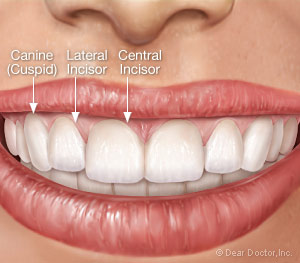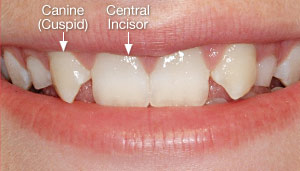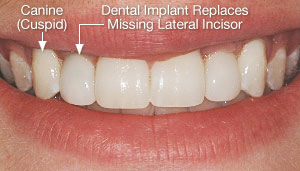When Permanent Teeth Don't Grow
Using orthodontics to help correct a developmental deficiency
Dear Doctor,
My daughter never developed the teeth right next to her upper front ones. My dentist is advising orthodontic treatment to make space and then have them replaced with dental implants. Why didn't they develop and is this the best plan of action?
Dear Monica,
What you are describing is a condition in which your daughter's lateral incisor teeth, the ones right next to the upper front two teeth, are congenitally missing (“con” – together with; “genital” – relating to birth). Missing one or more teeth is perhaps the most common congenital malformation in human beings. More than 20% of people lack one or more wisdom teeth (third molars) and more than 5% lack one or more second premolars or upper lateral incisors, so she is not alone.
 |
| The upper front teeth are shown in their correct position creating what is considered a normal smile. |
 |
| A smile looks abnormal when the lateral incisors are (congenitally) missing and the canines occupy their position next to the central incisors. |
 |
| After orthodontic treatment was used to move the teeth into normal position, implants replaced the congenitally missing lateral incisors — creating a normal smile and bite. |
The nature of congenitally missing teeth is genetic; the trait is inherited. Studies have shown that in many cases, multiple genetic and environmental factors act together. The importance of genetic factors is also notable in the appearance of multiple cases among relatives known as “familial clustering” and with a higher prevalence seen in identical as opposed to non-identical twins. It is also not uncommon for lateral incisors to appear misshapen or peg-shaped if they do develop.
What To Do
The larger question is, what is the best thing to do? Each tooth or, more accurately, each tooth type in the dental arches (upper or lower sets of teeth), has a specific function. When a particular tooth type is missing, it disrupts the pattern and function of the teeth and the arch. It's like removing a brick or two, in this case, from an arch, and seeing the rest of it shorten, if not collapse. When upper lateral incisors are missing, it is not uncommon for the canine teeth, sometimes known as the cuspid or “eye” teeth (the ones under the eyes), to move toward the central incisors to close the gaps. Very often this just doesn't look right, even to the layperson — there are four teeth where there should be six. Moreover, function is affected. The upper and lower canine teeth do not “occlude” or cover each other properly, so that they cannot function or grasp food correctly.
The most common treatment choice is to move the teeth in the upper arch (jaw) into the correct position by orthodontic means (braces), and then replace the missing lateral incisors artificially. The most natural-looking and conservative way to replace them, both aesthetically and functionally, is with dental implants because they do not attach to or damage adjacent teeth. Retainers or removable appliances can be made to hold the rest of the teeth in place until the implants can be placed. Artificial lateral incisor tooth replacements can also be attached to the retainers in the interim for a very natural and aesthetic appearance.
When To Do It — Timing Is Everything
There are several considerations you should be aware of before having dental implants. It is important that your daughter's jaw growth is complete before the implants are placed. Otherwise, the crowns of the teeth (which are connected to the implants) may appear to sink as the jawbone reaches maturity, usually around age 18. This generally occurs later in boys, since they typically don't complete jaw growth until their late teens to early twenties.
In addition, when the lateral incisors do not develop, neither does the bone that normally grows with them. Therefore, there may be insufficient bone volume to house and anchor the implants, which means bone may have to be generated surgically.
Team Players And Teamwork
Diagnosis of the problem, orthodontic positioning of the teeth, and timing of both replacement and restoration of the missing teeth are all imperative for long-term, successful results. Like many things in dentistry and in life, the right players and teamwork are critical to creating the optimal outcome. Therefore, your dentist is steering you in the right direction. While there are other ways to replace lateral incisors, today implants are generally regarded as the treatment of choice when possible, given the state of the art in dentistry right now. In fact, the orthodontist is often the team leader because he or she will make sure that your daughter's teeth are positioned properly and that jaw growth is complete before implants are placed. Then your daughter can have implant surgery and ultimately final crowns to replace the permanent lateral incisor teeth. All will be well that ends well.



